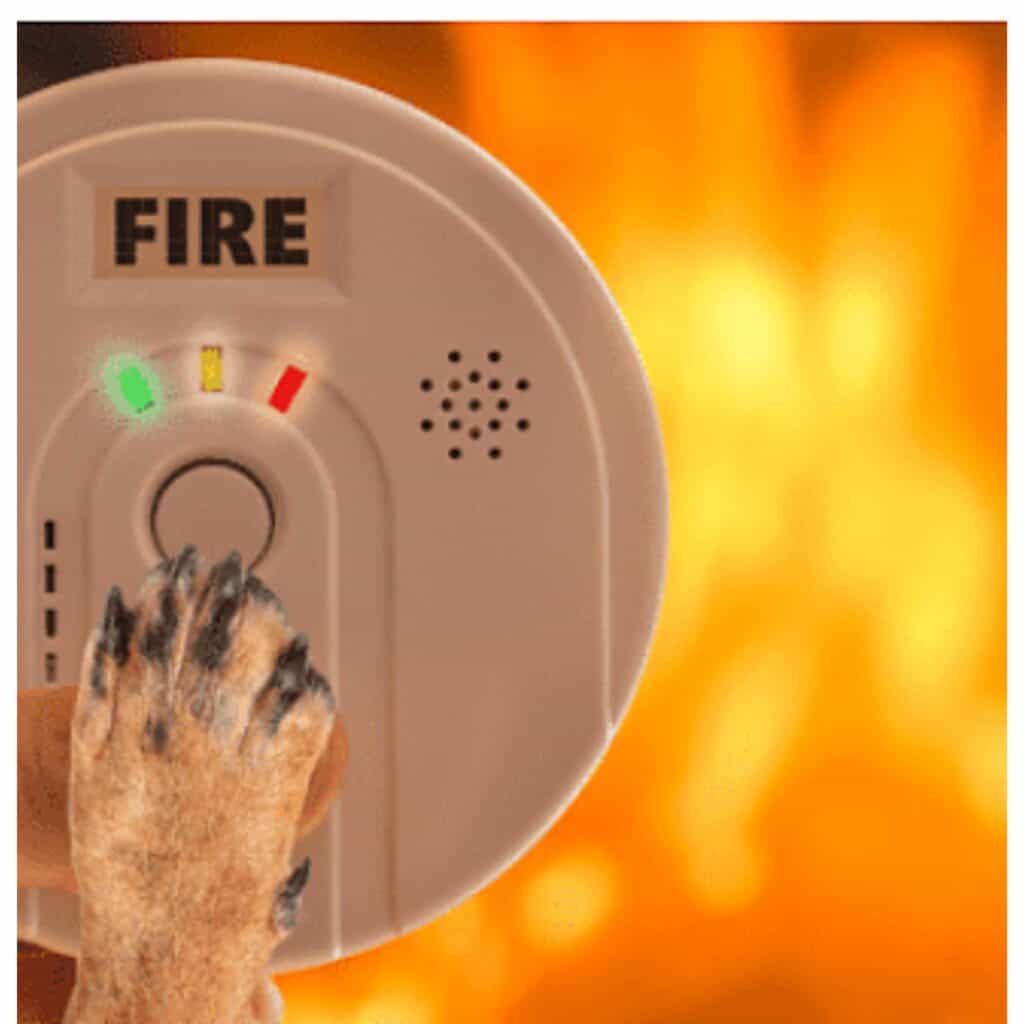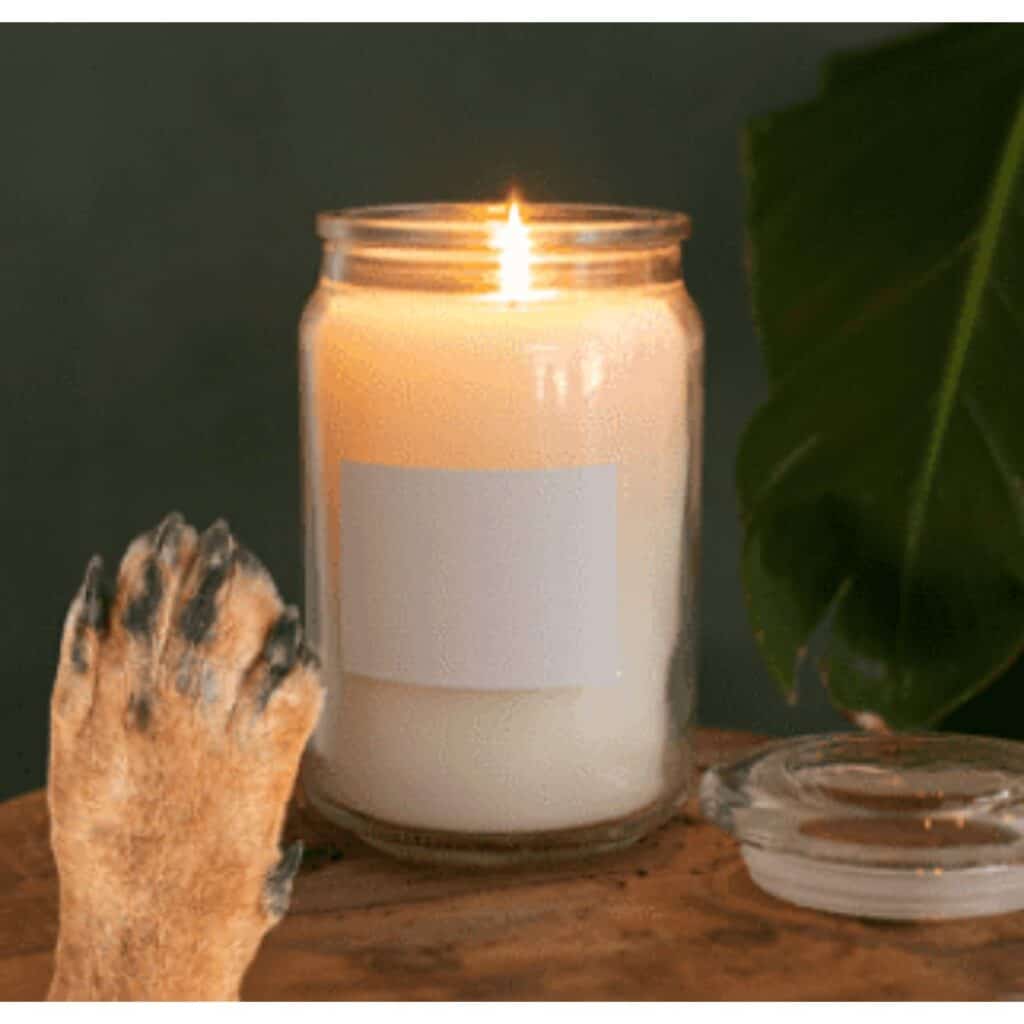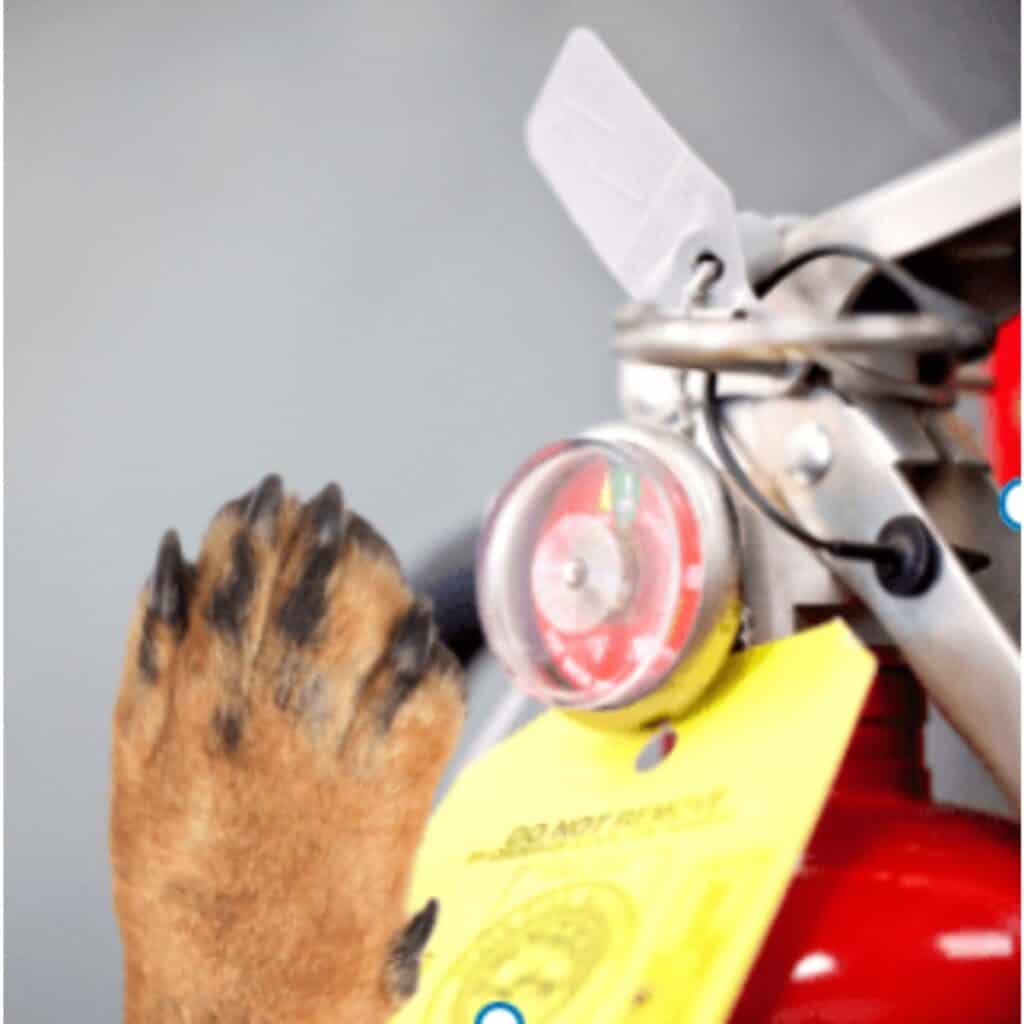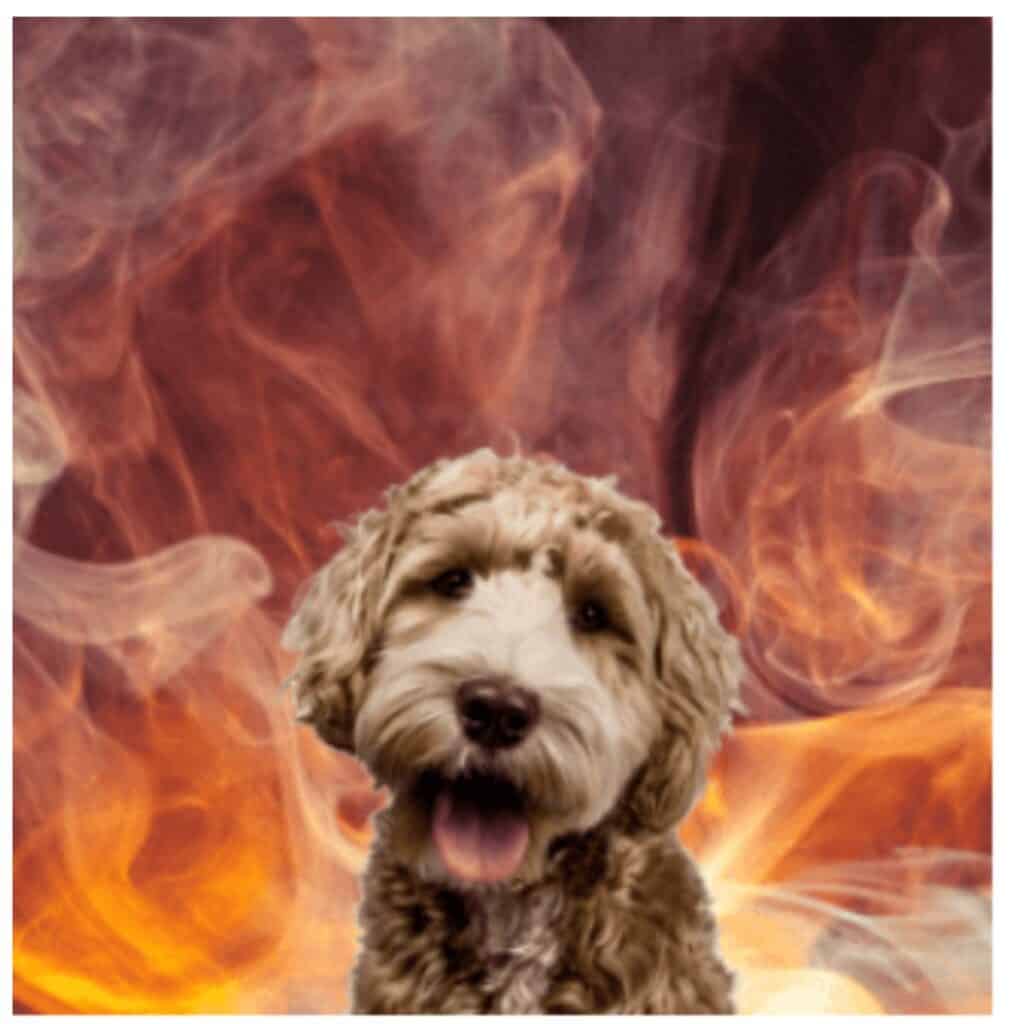National Pet Fire Safety Day is July 15th, 2023 and it is no coincidence that National Pet Fire Safety Day falls during the peak of wildfire season since it can serve as a great reminder for pet fire safety. Fires that affect pets start in many number of ways but the largest cause are outdoor and home fires.

50,000,000 pets are affected by fires annually says the Red Cross. We know that fires can be devastating for family members and spontaneous, therefore it’s crucial that pet owners be as prepared as possible.
Home Fire Statistics
The Zebra reported these amazing house fire statistics which indicates that fire safety should be of utmost importance to all:
- In a five-year period, house fires caused 2,620 deaths and $6.9 billion in property damage (NFPA).
- In 2018, the national average was 2.5 civilian fire deaths and 9.8 injuries per 1,000 fires (NFDR).
- The top three causes of fires in homes are cooking, heating equipment, and electrical malfunction (FEMA).
- It can take just 30 seconds for a small flame to turn into a major blaze (Department of Homeland Security).
- An average of 358,500 homes experience a structural fire each year (NFPA).
- More than 3,000 Americans die in fires each year (FEMA).
- Every day, at least one child dies from a fire inside the home (Stanford Children’s Hospital).
Pet Fire Safety Tips
The experts from the Best Friends Animal Society, the leading animal welfare organization working to end the killing of dogs and cats in America’s shelters by 2025, helped us put together the below tips to allow pet owners take fire safety precautions and be as prepared as possible in case a fire disaster strikes. These fire safety and prevention tips will also ward off the potential hazards of an event of a fire.
Sound the Fire Alarm

Make sure you have a working fire alarm and smoke alarm in your home. Be sure to use the test feature and check batteries regularly. Smoke alarms both detect smoke (as contrasted with heat or gases) and notify occupants of the presence of the threatening fire so they can escape. Smoke alarms are the life saving success story of the past 30 years in the fire safety world.
The New York Department of Health estimates that:
- Seventy percent of home fire deaths occur in homes with no smoke detectors or alarms or no working smoke alarms.
- The presence of a working smoke alarm in a home reduces the risk of dying in a fire by 50%. Approximately 890 lives could be saved annually if all homes had working smoke alarms.
Carbon monoxide alarms also save lives. Although Carbon monoxide does not increase the risk of fire, carbon monoxide alarms detect the poisonous gas and help provide an early warning. In the event of a carbon monoxide leak, it is critical that you and your pets get to fresh air as soon as possible and every second counts.
A Carbon Monoxide detector can help provide you and your family (pets included!) the advanced warning necessary to escape your home during an emergency. According to First Alert, the home detector company, if your carbon monoxide detector has replaceable batteries, they should be changed at least every 6 months. Although you replace the batteries, carbon monoxide alarms don’t last forever. They have a lifetime of 5 to 7 years, but it is important to refer to your user manual. After 5 to 7 years, replace the CO alarm completely.
Curb Pet Curiosity: Pets as Fire Starters
Pets are curious creatures, and that curiosity can cause fires. Pet proofing your home by keeping electrical equipment out of reach, and doing things like protecting stove knobs, manning the barbecue, replacing a lit candle with flameless candles, and using auto shut off space heaters can reduce the danger of a home fire caused by a curious pet.

Let First Responders Know Pets Live There
Put a pet alert sticker or pet alert window cling on each entrance of your home or front window near your front entrance that lets first responders know that you have a pet inside in case of an emergency.
It’s important to mark and keep the number of pets inside your house updated as it will save fire department rescuers time when attempting to locate your pets.
Keep Tags and Microchips Up-to-Date
In the event that you and your pet get separated, having up-to-date identification tags with critical information and microchips can help you and your furry friends be reunited as soon as possible.
Reduce Fire Hazards Around Your Home
According to the National Fire Protection Association the largest fire risks are cooking, smoking, candles, electrical and heating. If you notice loose wires or electrical cords that may be potential fire-starting hazards have them checked by an electrician. Find other electrical safety tips on the NFPA website here.
Have fire extinguishers available and serviced

Fire extinguishers also save lives but they need to be accessible, serviced regularly and users need to know how to use them.
Pet Fire Preparedness: What to Pack
Wildfires can displace communities for extended periods of time. Families with and without pets should have an fire safety plan that includes an evacuation plan and a list of emergency services at the ready in the event of a fire.
Pet parents should also have a bag of basic supplies ready in case emergency evacuation is necessary. Your pet emergency bag should include the following:
- A seven to ten-day supply of wet and/or dry food (and water, if possible)
- Your pet’s chew toy or treats
- An extra supply of any necessary medications (as veterinary care may not be readily available in a crisis)
- A list of your pet’s medical needs, medicines taken (including dosing/frequency), as well as veterinary contact information
- Copies of current vaccination records
- A collar with a current ID tag or microchip that includes your cell phone number
- A crate labeled with your pet’s name and your contact information (use masking tape and a permanent marker)
- Consider placing your well-worn sweater or sweatshirt inside the crate so that your pet travels more comfortably inside surrounded by a familiar scent around them.
- Leash and extra collar
- For cats, a small bag of litter and litter pan
- Blanket
- Towels
- ·Bowls
- Can opener and spoon
Fires of any nature are devastating and being separated from your pet or not having some of the essentials your pet needs and has come to depend on would only add to that devastation.
Fire Danger to Pet Health
Not only can fires destroy property but they can be devastating to the health of pets even if they survive. Smoke inhalation and burns are the most common injuries to pets that result from a fire, says Dr. Erin Katribe, Medical Director at Best Friends Animal Society. Symptoms of smoke inhalation can start anytime in the first 72 hours. Pets should be monitored for symptoms and signs of smoke inhalation.
“The most common clinical signs of dogs and cats that have experienced smoke inhalation injury are coughing or difficulty breathing due to damage to the respiratory tract,” warns Dr. Katribe. “Any respiratory distress is a true emergency and any pet experiencing labored breathing should be evaluated by a vet immediately. Other clinical signs related to smoke exposure include neurological signs (seizures, depression, stumbling) and cherry red gums and tongue. Clinical signs may be delayed, so monitor any pets exposed to wildfires or housefires closely following exposure.”

Conclusion
Accidental fires can occur anytime but by following these tips you may be able to keep your family members safe and healthy, including the furry ones.
Learn about out other ways to Keep Pets Safe:
How to Throw a Dog a Bone: Tips for Giving Your Dog a Bone Safely
Top Memorial Day Pet Safety Tips
July 4th Pet Safety Tips from Best Friends Animal Society
Pet Fire Safety FAQs
Pet fire safety is keeping your pet safe in the event of a fire. Fire statistics indicate that preparedness with fire alarms, signage to let first responders know where a pet is inside a home and taking precautions to prevent fires are all pet fire safety activities that save pets and peoples lives.
You can save a cat in a fire by first knowing where they are to protect them. Cats may hide with the sounds of a fire so you should immediately find your cat and place them in a crate, obtain and cat food or supplies you need and evacuate. Cats may need calming support after you confirm they are evacuated and safe.
Pets in a house fire that are not evacuated will suffer injury due to smoke inhalation which can cause long term health issues and even death. Additionally, there are other harmful gases that a pet will be exposed to during a fire like carbon monoxide. Pets will likely attempt to hide during a fire rather than attempt to escape which is why it is important to let first responders know pets are inside and evacuate them as soon as possible.
Find more dog advice and fun stories in our popular book called Motherpuppin’ Adorable: What to do when your dog is better than everyone else’s the perfect companion for navigating the best life with your dog. Learn more about this loved book.

